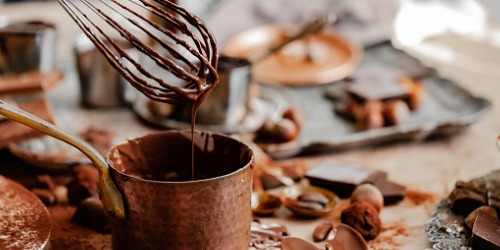What Adam Smith Ate (& Drank!): Chocolate
July 6, 2023

Hot chocolate was not as popular in England or Scotland as it was in France and Spain but Smith certainly would have known about it and perhaps tried in during his travels or at home.

Hot chocolate was not as popular in England or Scotland as it was in France and Spain but Smith certainly would have known about it and perhaps tried in during his travels or at home.
The answer is, we truly don’t know. Unlike claret or strawberries, we can find no record of Smith enjoying the exotic treat. However, it was popular enough during Smith’s time, we can assume he would have tried it. Also, we know Smith addressed the new-world exotic a treat in An Inquiry into the Nature and Causes of the Wealth of Nations, using it to illustrate what he believed worked – and didn’t work – when it came to luxury taxes and the common man.
Christopher Columbus first introduced chocolate to Spain in the 16th century when he brought cocoa beans with him from Mexico. It’s unclear how different Columbus’ concoction of beans ground with sugar for drinking would have been from what we think of as cocoa today. However, it might be safe to say it wasn’t as delicious since during the reign of Queen Elizabeth I, chocolate was consumed for medicinal purposes. It was also very expensive.
By the late 17th century, chocolate was becoming more ubiquitous and when mixed with sugar was consumed as a warm beverage. Scholar John Ray mentions drinking chocolate in his 1686 book The Natural History or Philosophical Collections and traded chocolate and sugar with his friend, London scholar and president of the Royal Society Hans Sloane. (Sloane would send the treat to Ray’s wife and daughters for which Mrs. Ray wrote a letter thanking him in 1700.)
It often made an appearance at breakfast. As Lucy Worsley notes in If Walls Could Talk: An Intimate History of the Home, “Samuel Pepys discovered it was a good cure for a hangover, relishing it especially when his head was ‘in a sad taking thro last night’s drink.’”
In France, drinking chocolate was a staple of the court of King Louis XV. In England, it was so popular at Hampton Court under William III there was a special private kitchen – the “Chocolate Court” – where the king’s personal hot-chocolate maker worked.
However, the biggest problem with chocolate was the price. It remained expensive because it was exclusively imported from Spain. Although, as Troy Bickham notes in his book Eating the Empire: Food and Society in 18th Century Britain (2020), “…plenty of people enjoyed it, especially when Sir Hans Sloane … whose private collections would form the basis of the British Museum in 1753, began marketing his patented milk chocolate as a digestive aid.”
In 1730, French chocolatier Doret opened a shop in London, offering chocolate primarily to aristocracy and other fashionable society followed by the now-famous Cadbury brothers who opened their first shop in London in 1763. While powdered chocolate could be used for drinking or flavoring baked goods, bar or shaped chocolate wouldn’t arrive until the mid-1800s. (It would be Queen Victoria who truly turned the world on to chocolate with her famous sweet tooth and love of elaborate chef-driven creations.)
Because of its uneven popularity, chocolate forms a part of Smith’s argument that all taxes are not created equally. As Smith notes, taxes on tea and sugar in England had an impact on everyone including the common man, just as a tax on chocolate would have a similar impact in Spain.
While drinking chocolate never became as ubiquitous in England as it did in Spain, it spread to at least one other country in Europe where it’s common for breakfast today – France. (King Louis XV’s recipe still survives.)
By the end of the Georgian era, hot chocolate was a staple of the British coffeehouse. In honor of Sir Sloane and to enjoy something close to what Smith might have sampled (or consumed on a regular basis), we’ve adapted Sloane’s hot chocolate recipe, courtesy of the British Museum.
Some recipes include mixing the chocolate with eggs and spices to make a sort of liquid custard or nog. We’ve taken a simpler approach hoping Smith would have approved.
Hot Chocolate (Drinking Chocolate) (serves 2-4)
· 2 cups whole milk
· 1 cup half and half
· 7 oz (200g) dark chocolate (at least 70%), finely chopped
· 1/8 tsp salt
· 2 tbsp sugar (or more to taste)
· 1/8 tsp vanilla extract
· Whipped cream or marshmallows
· Ground cinnamon, nutmeg, all spice, or smoked chipotle powder to sprinkle on top
1. In a saucepan, heat the milk and half-and-half over med-high heat until bubbles appear (don’t let it boil). Remove from the heat and add the chocolate and salt.
2. Return to a medium low heat and whisk constantly until chocolate has melted and is thoroughly incorporated into the mixture. Add the sugar (and adjust for taste) and the vanilla extract.
3. Pour into cups – makes 2 large mugs or 4 smaller cups – and add whipped cream, marshmallows, and spices to taste.
For a fun variation, try a flavored chocolate bar and adjust your seasonings accordingly.
Thirsty for more knowledge and/or beverages from Renee Wilmeth?
What Adam Smith Ate (& Drank!): Claret
What Adam Smith Ate: A Tribute to Strawberries
Adam Smith, Madame Geneva, and the Consequences of Liquor Prohibition
What Adam Smith Ate: Tea (& maybe Breakfast Scones)
Thirsty for more knowledge and/or beverages from Renee Wilmeth?
What Adam Smith Ate (& Drank!): Claret
What Adam Smith Ate: A Tribute to Strawberries
Adam Smith, Madame Geneva, and the Consequences of Liquor Prohibition
What Adam Smith Ate: Tea (& maybe Breakfast Scones)